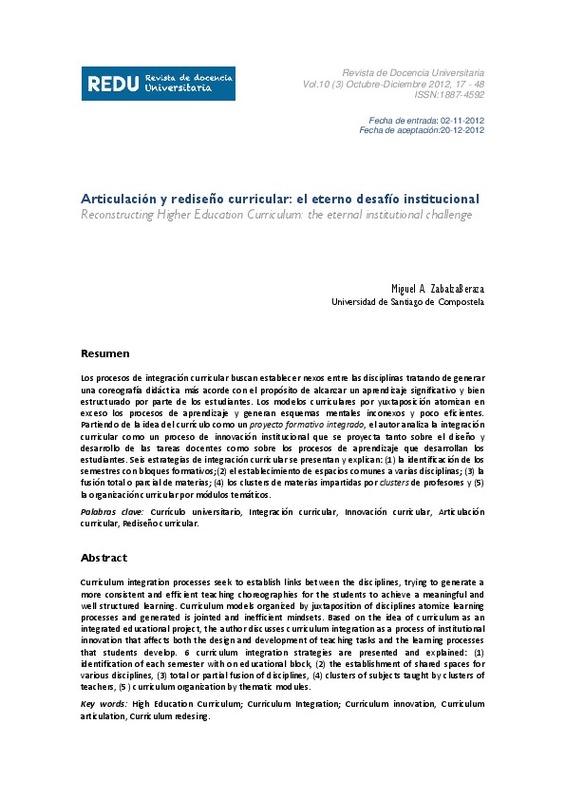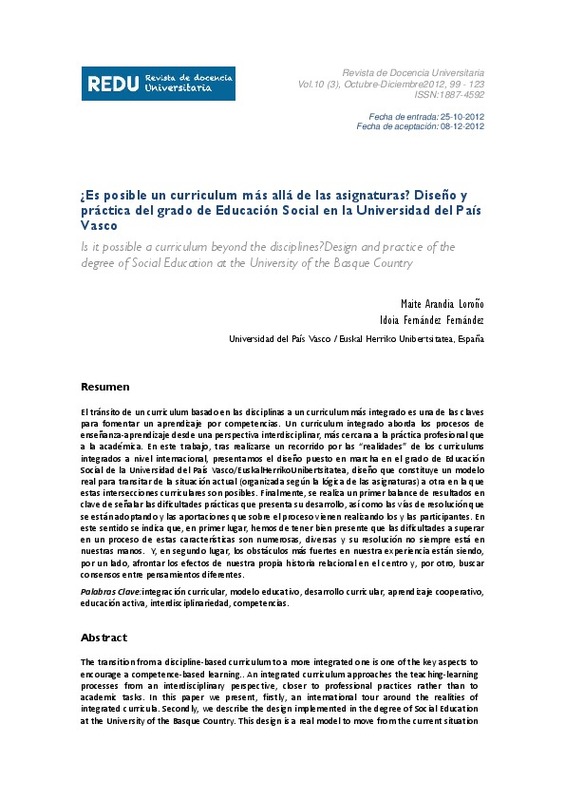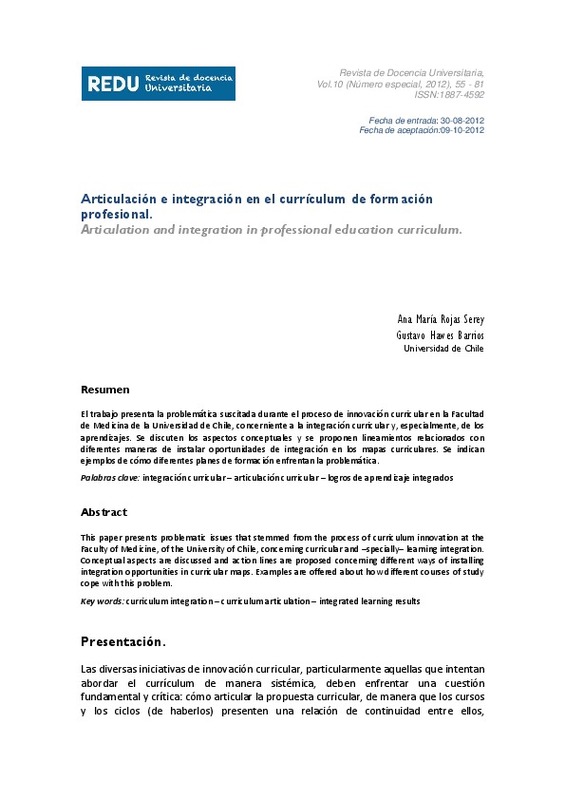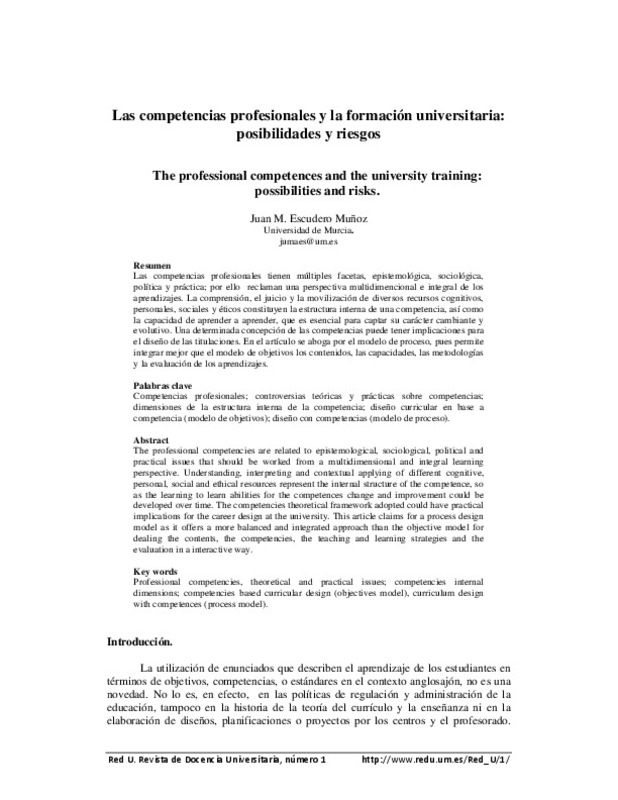JavaScript is disabled for your browser. Some features of this site may not work without it.
Buscar en RiuNet
Listar
Mi cuenta
Estadísticas
Ayuda RiuNet
Admin. UPV
Articulación y rediseño curricular: el eterno desafío institucional
Mostrar el registro sencillo del ítem
Ficheros en el ítem
| dc.contributor.author | Zabalza Beraza, Miguel A.
|
es_ES |
| dc.date.accessioned | 2020-04-23T09:00:07Z | |
| dc.date.available | 2020-04-23T09:00:07Z | |
| dc.date.issued | 2012-12-31 | |
| dc.identifier.issn | 1887-4592 | |
| dc.identifier.uri | http://hdl.handle.net/10251/141368 | |
| dc.description.abstract | [ES] Los procesos de integración curricular buscan establecer nexos entre las disciplinas tratando de generar una coreografía didáctica más acorde con el propósito de alcanzar un aprendizaje significativo y bien estructurado por parte de los estudiantes. Los modelos curriculares por yuxtaposición atomizan en exceso los procesos de aprendizaje y generan esquemas mentales inconexos y poco eficientes. Partiendo de la idea del currículo como un proyecto formativo integrado, el autor analiza la integración curricular como un proceso de innovación institucional que se proyecta tanto sobre el diseño y desarrollo de las tareas docentes como sobre los procesos de aprendizaje que desarrollan los estudiantes. Seis estrategias de integración curricular se presentan y explican: (1) la identificación de los semestres con bloques formativos;(2) el establecimiento de espacios comunes a varias disciplinas; (3) la fusión total o parcial de materias; (4) los clusters de materias impartidas por clusters de profesores y (5) la organización curricular por módulos temáticos. | es_ES |
| dc.description.abstract | [EN] Curriculum integration processes seek to establish links between the disciplines, trying to generate a more consistent and efficient teaching choreographies for the students to achieve a meaningful and well structured learning. Curriculum models organized by juxtaposition of disciplines atomize learning processes and generated is jointed and inefficient mindsets. Based on the idea of curriculum as an integrated educational project, the author discusses curriculum integration as a process of institutional innovation that affects both the design and development of teaching tasks and the learning processes that students develop. 6 curriculum integration strategies are presented and explained: (1) identification of each semester with on educational block, (2) the establishment of shared spaces for various disciplines, (3) total or partial fusion of disciplines, (4) clusters of subjects taught by clusters of teachers, (5 ) curriculum organization by thematic modules. | es_ES |
| dc.language | Español | es_ES |
| dc.publisher | Universitat Politècnica de València | es_ES |
| dc.relation.ispartof | REDU. Revista de Docencia Universitaria | es_ES |
| dc.rights | Reconocimiento - No comercial - Sin obra derivada (by-nc-nd) | es_ES |
| dc.subject | Currículo universitario | es_ES |
| dc.subject | Integración curricular | es_ES |
| dc.subject | Innovación curricular | es_ES |
| dc.subject | Articulación curricular | es_ES |
| dc.subject | Rediseño curricular | es_ES |
| dc.subject | High Education Curriculum | es_ES |
| dc.subject | Curriculum Integration | es_ES |
| dc.subject | Curriculum innovation | es_ES |
| dc.subject | Curriculum articulation | es_ES |
| dc.subject | Curriculum redesing | es_ES |
| dc.title | Articulación y rediseño curricular: el eterno desafío institucional | es_ES |
| dc.title.alternative | Reconstructing Higher Education Curriculum: the eternal institutional challenge | es_ES |
| dc.type | Artículo | es_ES |
| dc.identifier.doi | 10.4995/redu.2012.6013 | |
| dc.rights.accessRights | Abierto | es_ES |
| dc.description.bibliographicCitation | Zabalza Beraza, MA. (2012). Articulación y rediseño curricular: el eterno desafío institucional. REDU. Revista de Docencia Universitaria. 10(3):17-48. https://doi.org/10.4995/redu.2012.6013 | es_ES |
| dc.description.accrualMethod | OJS | es_ES |
| dc.relation.publisherversion | https://doi.org/10.4995/redu.2012.6013 | es_ES |
| dc.description.upvformatpinicio | 17 | es_ES |
| dc.description.upvformatpfin | 48 | es_ES |
| dc.type.version | info:eu-repo/semantics/publishedVersion | es_ES |
| dc.description.volume | 10 | es_ES |
| dc.description.issue | 3 | es_ES |
| dc.identifier.eissn | 1887-4592 | |
| dc.relation.pasarela | OJS\6013 | es_ES |
| dc.description.references | Ashwin, P. (2009). Conceptualising Teaching and Learning Interactions in Researching Higher Education. En M. Tight et alii, The Routledge International Handbook of Higher Education. London: Routledge. Pg. 37‐46. | es_ES |
| dc.description.references | Beane, J.A. (2005). La integración del curriculum, el diseño del núcleo de la educación democrática. Madrid: Morata. | es_ES |
| dc.description.references | Berman, P. (1982). Educational Change: an implementation paradigm, en R. Lehming y M. Kane. Improving Schools: using what we know. Beverly Hills: Sage. Pg. 253‐ 286. | es_ES |
| dc.description.references | Bricall, J.M. (coord.) (200 0). Universidad 2000. Madrid: CRUE (Conferencia de Rectores de las Universidades Españolas). | es_ES |
| dc.description.references | Brophy, J.E. y Good, Th.L. (1986). Teacher Behaviour and Student Achievement. En M.C. Wittrock. Handbook of Research onTeaching: third edition. New York: Mac Millan. Pag. 328‐375. | es_ES |
| dc.description.references | Chaves, A.L.; Hernández, D. y León, J. (2011). La integración curricular. Una experiencia en el primer nivel de diplomado de la carrera de Licenciatura en Pedagogía con énfasis en Educación Preescolar. Revista Electrónica Educare, XV (2), 63‐86. | es_ES |
| dc.description.references | Delors, J. et al. (1996). La Educación encierra un tesoro. Madrid. Unesco‐Santillana. | es_ES |
| dc.description.references | Escanero, J.F. (2007). Integración curricular. Educación Médica,10 (4), 217‐224. | es_ES |
| dc.description.references | Fullan, M.G. (1982). The Meaning of Educational Change. Toronto: OISE Press. | es_ES |
| dc.description.references | Glover, D.C.; Glenson, D.; Gough, G. y Johnson, M. (1998). The Meaning of Management : the development needs of middle manager in secondary schools", en Educational Management and Administration, 26 (3), 279‐292. | es_ES |
| dc.description.references | Haggis, T. (2009). Student Learning Research: a broader view. En M. Tight et alii, The Routledge International Handbook of Higher Education. London: Routledge. Pg. 23‐36. | es_ES |
| dc.description.references | Harden RM, Davis MH, Crosby JR. (1997). The new Dundee medical curriculum: a whole that is greater than the sum of the parts. Medical Education, 31:264‐71. | es_ES |
| dc.description.references | Harden, R.M. (2000). The integration ladder, a tool for curriculum planning and evaluation. Medical Education 2000, 34: 551‐557. | es_ES |
| dc.description.references | MacGregor, D. (1994). El lado humano de las organizaciones. Madrid: MacGraw‐Hill | es_ES |
| dc.description.references | Mello Carvalho, I. (1974). El proceso didáctico. Buenos Aires: Kapelusz | es_ES |
| dc.description.references | Menges, R. J. (1997). Fostering faculty motivation to teach. Approaches to faculty development, en J.L. Bess (Edit.): Teaching well and liking it. Motivating faculty to teach effectively. Baltimore: John Hopkins University Press, pp. 407‐423. | es_ES |
| dc.description.references | Oser, F.K. e Baeriswyl, F.J. (2001). Choreografies of Teaching: bridging instruction to teaching, en V. Richardson (Edit.): Handbook of Research on Teaching (4th Edition). Washington: AERA, ps. 1031‐1065. | es_ES |
| dc.description.references | Shulman, L.S. (1986). Paradigms and research programs in the Study of Teaching: a contemporary perspective. En M.C. Wittrock. Handbook of Research onTeaching: third edition. New York: Mac Millan. Pag. 3‐36 | es_ES |
| dc.description.references | Villarini Jusino, A. (2000). El currículo orientado al desarrollo humano integral y al aprendizaje auténtico. Río Piedras, P.R: Organización para el Fomento del Desarrollo del Pensamiento, Inc. | es_ES |
| dc.description.references | Wittrock, M.C. (1986). Handbook of Research on Teaching: third edition. New York: Mac Millan | es_ES |
| dc.description.references | Zabalza Beraza, M.A. (2000). El papel de los departamentos universitarios en la mejora de la calidad de la docencia, en Revista Interuniversitaria de Formación del Profesorado, 38, p. 47‐66. | es_ES |
| dc.description.references | Zabalza, M.A. (2003). Competencias docentes del profesorado universitario. Madrid. Narcea. | es_ES |
| dc.description.references | Zabalza, M.A. y Zabalza Cerdeiriña, M.A. (2012). Innovación y cambio en las instituciones educativas. Rosario, Argentina: Homo Sapiens. | es_ES |











